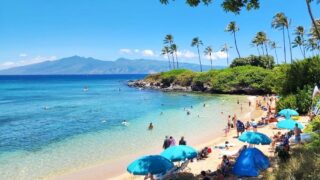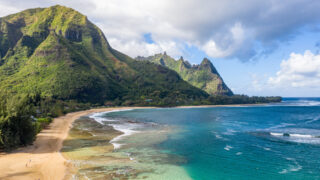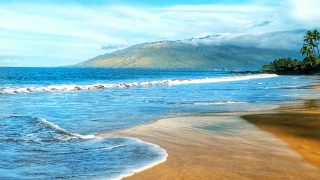A new blueprint for Hawaii tourism is coming. It is fraught with issues in typical Hawaii fashion, including diverse opinions and all of the in-fighting at Hawaii’s marketing entities. Nonetheless, one thing is clear that old school Hawaii tourism is ending.
It’s time to say goodbye to the golden era of Hawaii tourism that reigned for sixty years, from the 1960s through 2019. It was a great run, and both Hawaii and visitors loved it and benefited. It’s a shared legacy that began with the advent of jet travel.
60 Years Ago Elvis’ Blue Hawaii + Jets Transformed Hawaii Travel
As we pay respects to some Hawaii visitors of the past who are choosing not to return and to mass tourism moreover, we bid farewell to aspects of the industry that is stereotyped in iconic picture-perfect images such as the one above. What a journey it has been. Kicking and screaming (one and all), we are entering a time of seismic shift in Hawaii travel, and simply nothing less.
So what happened, and what comes next?
Over the past sixty years, tourists have loved Hawaii to death. Whether it is Hanauma Bay, the road to Hana, North Shore Kauai, or a list of other epic Hawaii destinations, over-tourism has taken an enormous toll on the environment and Hawaii’s people. During Covid, the world did a rethink, and what became apparent was that many things would change when tourism resumed.
Don’t worry; the sandcastles of your dreams aren’t entirely gone. Yet, a new vision and related images for our still-iconic destinations are being envisioned that is a future co-created by and benefiting residents, the Hawaii travel industry, and visitors.
This new quality of life and environmental focus is not unlike what is happening at other overtouristed places like Bali, Machu Picchu, and Barcelona. Another example is France’s national parks and countryside towns that have implemented systems and strategies to manage traffic flow amid the summer travel boom. “What we’re trying to do, especially for the national markets like Paris and the French people, is to get people to come year-round rather than during the summer or peak period.” They’ve also introduced visitor quotas, advance reservations, and fees. Sound familiar?
Hawaii and many other destinations such as these are forging new paths where tourism provides more significant benefits for visitors and residents.
“Localhood” Hawaii.
In some places, it is referred to as “localhood,” which means thinking of visitors more as temporary residents than as tourists. While not a literal translation, it implies that visitors and residents are essential elements of the same Hawaii ecosystem, with responsibilities and benefits that result in a better and more harmonious Hawaii for all. It is a long-term vision with human relations as its focal point and where visitors and residents co-exist and co-create. Hawaii needs to find ways for the industry, residents, and visitors to work together in ways that all will benefit. And that isn’t working in Taro fields, as mentioned in Are You The Tourists Hawaii Wants.
There will be no more growth for growth’s sake.
Until now, that has been the primary focus of the Hawaii Tourism Authority since its creation. Developing new experiences in Hawaii tourism, including culture and “localness.”
Moving from a visitor growth model to a visitor value model is the next big hurdle. Creating a better experience for visitors and residents along the way is very much needed.
Hawaii has a chance to lead globally in creating its new travel paradigm.
But does it have the wherewithal and resources to be a thought leader? So far, it is slow in coming. It isn’t emanating from HTA or HVCB, which, as you recall, was just booted out as the HTA partner after 120 years of Hawaii marketing. Is it Council for Native Hawaiian Advancement? That’s HTA’s chosen but likely court-contested new partner. Given their lack of experience and singular focus on Native Hawaiian issues, we question that.
Let’s continue valuing repeat visitors. The last report said 68% of visitors are returning.
The importance of return visitors can’t be more obvious, although Hawaii marketeers HTA and HVCB seem to have missed this point entirely. It’s about visitors having quality experiences they want to share. One quality Hawaii visitor should beget another. Right now, we aren’t sure that is happening as it used to. You see it in the comments here. Are you telling your friends to return or not?
Can Hawaii make efforts to retain its return guests who have been the meat and potatoes of our legacy tourism income? Return visitors may be the more accessible guests to please, with less negative impact. They are also the best advocates for Hawaii. Return guests spend more and are more satisfied with their Hawaii vacation.
An interesting comment from regular Cheryl regarding return visitors: “IMO the return visitors are precisely the people the state should be concerned about losing. Those of us who return year after year know and love the island, and its people and treat it as if it is our second home. When you price the “returners” out of the market, what you are left with are people who look for the $29 fares and a week of partying who have little regard for the culture or the people, or the super wealthy who are there to be waited on hand and foot and who could care less about the locals. The return visitors pump a lot of money into the economy, we just do it differently than the people who come for a week or so, and the state is leaving us little choice but to look elsewhere for a place to spend our winters.”
Hawaii also needs new visitors from emerging markets.
Many of you have mentioned that in the comments. Whether it is the upcoming nonstop flights from London or those from Southeast Asia or Japan, Hawaii wants to attract visitors of a mindset that aligns with the new travel paradigm.
What are some first steps to participate in the new Hawaii travel?
1. Including sustainable tourism in your Hawaii travels. That can be as simple as selecting nonstop flights instead of connecting ones since most environmental damage happens during take-off and landing.
2. Going green at your Hawaii destination. Consider not having your sheets and towels changed daily. Turn off the air conditioning, fan, and other electronics when leaving your room. Use recycling programs or do your own. Travel with reusable water bottles, mugs, shopping bags, containers, and other things that reduce single-use disposable items.
3. Taking special care of Hawaii heritage places.
4. Find new and proactive ways to step outside of your comfort zone.
UH School of Travel Management was right about one thing.
They said that if you can’t reduce tourism, make it regenerative. And regenerative it will be. It referred to planting taro and cleaning up beaches, which you were most outspoken about not favoring as ways to spend your hard-earned Hawaii vacation. So then, what will it look like?
Part of what it will include is making tourism more attractive to Hawaii residents. The study called it “tourist attractiveness” and looked at ways to reduce negative feelings towards tourists. Lofty goals are not specific in mind, but we get the point clearly.
We are set to lumber towards a goal of more sustainable, regenerative tourism.
It is going to be awkward. We will get there. The world is heading in this direction, and we’ll be a part of that movement.
Removing the stigma of being anti-tourist.
In the process, can Hawaii do anything to remove the perception that it is anti-visitor? Since that has primarily resulted from over-tourism, what can Hawaii do to mitigate tourism’s negative impact and improve perception?
Managing escalating Hawaii vacation costs.
It isn’t just Hawaii that has suddenly gotten very expensive. Instead, it is global. Yet it is such a focus for value-oriented Hawaii tourists who have enjoyed relatively cheap Hawaii vacations for years. With car rentals, as an example, Hawaii has nothing whatsoever to do with the lack of availability or the costs (other than taxes). But it is thrown into the “blame Hawaii bucket” about overall vacation costs. Then there are the highest visitor accommodation taxes in the country. That is something that Hawaii is in control of, and adding 3% across the board recently, didn’t help. Accommodations are gouging, and airfares are also on the rise.
How do you feel about the changes afoot in Hawaii tourism?
Get Breaking Hawaii Travel News







If you’re going to compare Disneyland to Hawaii you are most definitely part of the problem.
That said, I do not believe that these negative comments have been posted by hundreds of separate visitors. I also don’t understand what is to be gained from the bashing. If you really don’t want to visit just move on. Don’t cause yourself any more anguish.
I choose not to take your “part of the problem” insinuation personally, Peg. If you don’t understand my correlation just let it go. It has Nothing to do with Hawaii being Disneyland. It has Everything to do with marketing smarts like Disney had. I have been watching what happens with our Islands since 1983 and I can say this: folks insulting others has Always been “part of the problem.”
Hi PegM,did you ever consider that many who comment have a vested interest of some kind? Imagine having frequently vacationed in Hawaii and kept returning year after year, it’s as if it is a second home. Now to be torn apart by what is occurring. A portion of yourself says Hell No, I’m Done while the rest is saying We Will be Back! This is where many find themselves, They will return some day, probably, and the worse Hawaii becomes will determine the finality of the situation for most.
We have all read the book Maui Revealed. Everything I have been saying is in the lasted edition. Very few people have been lucky enough to have traveled to Maui for over 26 years. Most people go once or twice and normally close in time to each vacation. But you go so many times over an extended period of time and see the wonders of Maui be restricted more and more and more and more for dumb reasons. Selfish reasons or because the locals think that they own public land more than anyone else, it becomes beyond frustrating. The magic of Maui is its nature and when you’re not allowed to experience nature at your own time and pace or at all, then it becomes Disneyland.
I speak with basically 3 (maybe 4), types of locals in my circles
1. Natives who hate tourists
2. Transplants who think that now that they are considered kama’aina they can now hate tourists with impunity.
3. Natives and transplants who recognize tourist’s role in our jobs and economy but think it’s too far gone.
4. #3’s who believe that there’s hope for the future.
BofH’s comments about the absolute need for return tourists is Spot On!
One and done is a formula for defeat, and it’s why Walt Disney not only designed cool stuff, but modified the appearance regularly to keep returning tourists getting a slightly new experience each time.
Your thoughts?
“Cheryl”s comment was astute and accurate and I agree completely. However, there is a comment by Jennai with which I have to disagree. “Entitled” tourists make me insane and angry. The folks that just need to check a “week in Hawaii” off their bucket list and just come to party – I wish they would just stay away. However, those folks are not limited to Hawaii! That is the culture we have created and allowed and it “takes it out” on popular warm beach locations all over the US and, much to my chagrin, I would suspect all over the world. As for having “locals” vandalize your car, how do you know it was a “local” And why did they choose your car – did you leave “tourist stuff” visible. In over 50 visits to Hawaii, we’ve never had an issue.
As a recent visitor of two of Hawaii’s beautiful islands, I can safely say between the locals vandalizing our rental car and the tourists behaving as entitled, selfish people Hawaii isn’t at all welcoming to casual vacationers. If you don’t want to find yourself fighting both the Sharks and the Jets just choose a different vacation spot. Not worth the money, time, and stress to come to Hawaii.